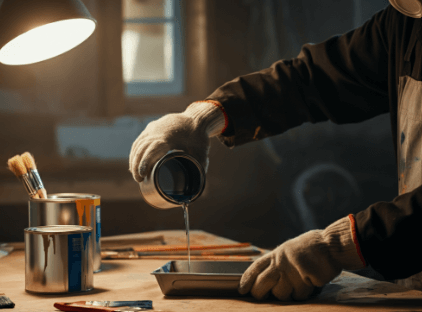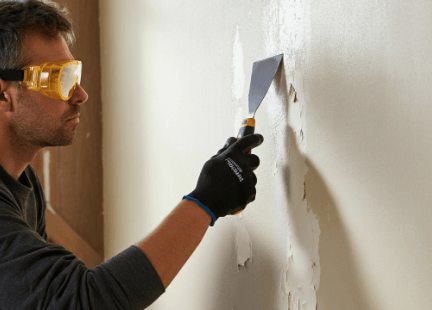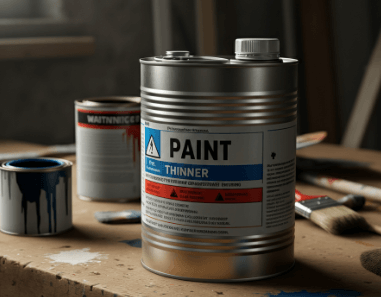Are you a home improvement enthusiast or a DIY lover looking to elevate your projects? Understanding how to use paint thinner effectively can make all the difference. This blog post guides you through advanced techniques to take your skills to the next level. Whether you’re a house buyer, seller, or real estate investor, mastering how to use paint thinner will improve the quality and finish of your work. From learning about the suitable types of paint thinner to practical tips on their application, we’ve got you covered.
Steve Daria and Joleigh, experienced real estate investors, know the importance of maintaining their properties precisely and carefully. Effectively using paint thinner is one of their go-to techniques for ensuring a flawless finish on walls and trim. By following tried-and-true methods, they achieve professional results that enhance the value and appeal of their investments.
What is Paint Thinner?
Before discussing the step-by-step on how to use paint thinner, it’s essential to understand that paint thinner is a solvent primarily utilized to thin oil-based paints and clean up after painting.
It works by breaking down the oils in the paint, making it easier to apply and clean.
Common paint thinners include mineral spirits, turpentine, and acetone, each with unique properties and applications.

Different Types of Paint Thinner
Understanding the different types of paint thinners available will help you choose the right one for your project.
Here are some commonly used options:
- Mineral Spirits: Ideal for thinning oil-based paints and varnishes.
- Turpentine: Known for its strong odor, it’s excellent for artists and craftspeople.
- Acetone: Is a powerful solvent often used to remove nail polish and clean surfaces.
Benefits of Using Paint Thinner
Why should you incorporate paint thinner into your home improvement projects?
The benefits are numerous:
- Enhanced Paint Flow: Thinning paint improves flow, producing a smoother finish.
- Efficient Cleaning: Easily clean brushes, rollers, and other tools.
- Versatility: Suitable for various applications beyond just thinning paint.
Get An Offer Today, Sell In A Matter Of Days…
Preparing Your Workspace
Preparation is critical to success in any DIY project.
Due to its chemical properties, this becomes even more critical when working with paint thinner.
Safety Precautions
Paint thinner contains volatile organic compounds (VOCs) such as acetone, toluene, and xylene, which can be harmful if inhaled or ingested.
It’s important to work in a well-ventilated area with windows and doors open to allow air circulation and prevent the buildup of fumes.
Additionally, wearing protective gear such as nitrile gloves, safety goggles, and a respirator or mask rated for organic vapors is essential to minimize exposure to the chemicals in paint thinner.
Essential Tools
Having the right tools on hand will make your job easier and safer:
- Protective Gear: Gloves, masks, and goggles.
- Containers: Metal or glass containers for mixing and storage.
- Ventilation Equipment: Fans or exhaust systems.
Advanced Techniques on How to Use Paint Thinner
With the basics covered, let’s explore some advanced techniques on how to use paint thinner.
Thinning Paint for Spraying
Thinning paint for spray applications requires precision.
Here’s how to do it effectively:
- Measure Accurately: Use a measuring cup to ensure the correct ratio of paint to thinner.
- Mix Gradually: Add the thinner slowly, stirring continuously.
- Test Consistency: Conduct a test spray to check the consistency before applying it to your project.
Cleaning Painting Tools
Cleaning tools like brushes and rollers can be a hassle, but paint thinner makes it easier:
- Pre-Cleaning: Wipe off excess paint from the tools.
- Submerge and Swirl: Submerge the tools in paint thinner and swirl to break down the paint.
- Rinse and Dry: Use warm water and allow them to dry completely.
Removing Paint from Surfaces
Sometimes, you need to remove old paint before starting a new project.
Paint thinner can help:
- Apply Generously: Apply a cloth soaked in paint thinner to the painted surface.
- Scrub Gently: Use a brush or scouring pad to scrub off the paint.
- Clean Residue: Put away any remaining residue with a clean cloth.

Frequently Asked Questions
To address common queries, here are some frequently asked questions about how to use paint thinner:
Is Paint Thinner Safe to Use?
Paint thinner contains chemicals such as acetone, toluene, and methanol, which can pose health risks if not handled properly.
Using paint thinner in a well-ventilated or open area is essential to minimize fume exposure.
Wearing correct protective gear, such as gloves and a respirator, further reduces the risk of inhalation or skin contact with the chemicals.
Can Paint Thinner Be Applied on All Types of Paint?
Paint thinner is specifically formulated for use with oil-based paints, varnishes, and stains.
It works by breaking down the oils and resins in these paints, making them thinner and easier to work with.
However, using paint thinner on water-based paints can lead to issues such as poor adhesion, streaking, or even damage to the paint surface.
How Do I Keep Paint Thinners?
Paint thinners have to be stored in a cool, dry place to preserve their effectiveness and safety.
Exposure to direct sunlight and high temperatures could degrade the quality of the thinner over time, affecting its ability to properly thin paints or clean brushes.
It’s crucial to keep paint thinner away from open flames or sources of ignition, as it is highly flammable.
Conclusion
Paint thinner is an invaluable tool for anyone engaged in home improvement or DIY projects. By understanding its properties, benefits, and advanced techniques on how to use paint thinner, you can enhance your projects’ quality and efficiency.
Whether you’re thinning paint for a smoother finish, cleaning tools, or removing old paint, mastering the use of paint thinner will set you apart in the DIY world. Ready to take your projects to the next level? Apply these tips and strategies to make the most out of paint thinner.
**NOTICE: Please note that the content presented in this post is intended solely for informational and educational purposes. It should not be construed as legal or financial advice or relied upon as a replacement for consultation with a qualified attorney or CPA. For specific guidance on legal or financial matters, readers are encouraged to seek professional assistance from an attorney, CPA, or other appropriate professional regarding the subject matter.

